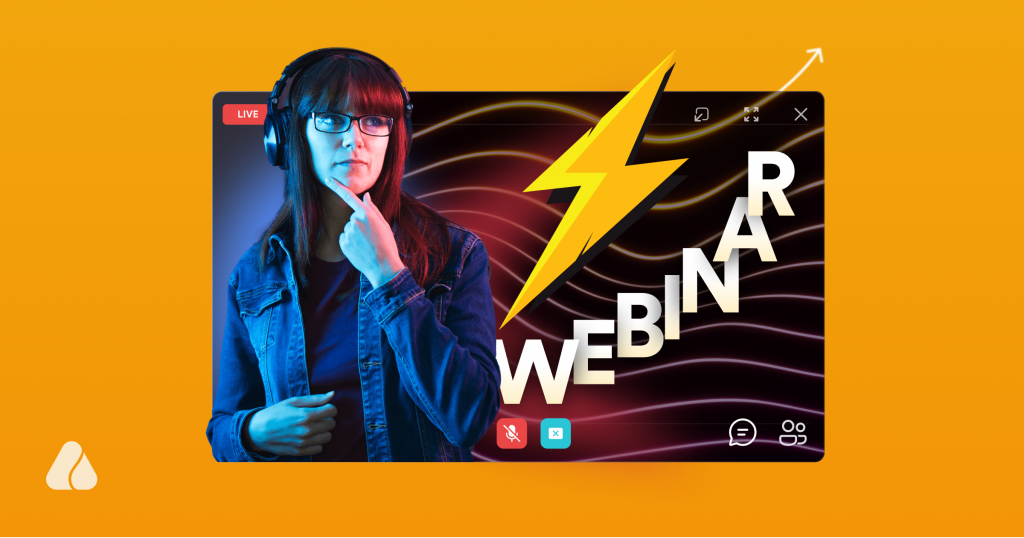A
re you planning a webinar? Don’t know which tool to use for an engaging virtual event? This blog will help to choose the right tools for your next upcoming webinar.
Let’s begin with the basics – why go ahead with webinars?
Table of Contents
Today, many companies utilize webinars as a central part of their marketing strategy and not without reason.
Webinars are excellent sources of information.
It can be recorded and reused across multiple events, across social media channels like Facebook and LinkedIn to promote a product and create brand awareness. And, last but not least, used to build your community.
But to do so, you need your webinar to look crisp, polished, and professional. You require a flawless set up so that the quality is not compromised.
Let’s begin by understanding the tools you can’t do without when you plan to host any webinar.
What is a Webinar Equipment?
Webinar equipment is the technological tools used to conduct webinar sessions. It involves hardware and software such as desktop/laptop microphones, headset, webcam, lighting, presentation software, and more. These pieces of equipment not only enhance the delivery of your webinar presentation but also create an engaging experience for a virtual audience.
Audio equipment for webinars
Sound is one of the most critical parts of your webinar. The audience loses interest in webinars if the sound quality is not good, and the chances are that they won’t join your future webinars.
When the audience is asked to rate a webinar, most of them rate it higher when the audio quality is premium. For top-notch sound quality, you require a high-quality microphone with or without a headset. Here are a few of our recommendations.
Headset
Headsets are meant to deliver clear sound, blocking any surrounding noise. If your webinars feature other panelists or want your attendees to speak up on a virtual stage, you should invest in a headset to minimize the feedback audio.
A simple pair of headphones from a good brand should do. Some speakers prefer to have a headset with a microphone where they can listen and record. Check if your headset requires to be charged before you go live, or you can do a plug-and-play. If you happen to travel frequently, select one which can be folded and packed quickly.
Microphones
While your computer or laptop likely has a built-in internal mic, investing in a standalone mic is advisable to achieve superior sound quality. That could be a headset microphone or a mic that is kept on your desk.
If you are hosting the webinar, try using a discreet microphone and a not-so-visible headset for better optics. The microphone should have a plug-and-play feature and be compatible with leading computer operating systems like Mac and Windows.
There are two main types of microphones, Dynamic and Condenser. Dynamic mics are robust and loud, primarily used in a live setting to amplify sound and cover the background noise or recording space’s acoustics. It is cheaper and more durable but not very sensitive to softer sounds.
Condenser mics are capable of capturing those finer sounds with higher precision and are designed for studio settings. This one is more sensitive to background noise and requires an external power source. Choose the one that best suits your requirement.
Video equipment for webinars
Hosts can leverage webinar recordings and prolong your event’s life, delivering value long after completing the event. The recordings can be shared on social media like Facebook and Youtube with those who couldn’t attend the event or on social media platforms in the form of clippings. When the video feed is clear, it feels more like an in-person event.
To make high-resolution videos that look sharp and lively, you will require:
Webcam
Every laptop/computer has a built-in webcam, but with an external webcam you can zoom, pan, and autofocus – which isn’t possible with built-in webcams. The webcam should have a glass camera with auto-focus, full HD streaming at 1080p, digital zoom, automatic low-light compensation and should be compatible with every browser and operating systems.
Video Editing Software
Before your webinar production, keep a video editing software ready as you may want to show particular video clipping during the webinar. You can cut, edit, and show the video’s required part without wasting time.
Image editing Tool
The image editing tool is another worthy investment where you have to insert, crop, and edit images to be shown during the webinar. You can use this tool to prepare the webinar invite and registration page along with the presentation.
Want to look good when hosting your next webinar? Here is a beginner’s guide on how to look good on a webcam 😉
Lighting
This is the most overlooked piece of equipment, but its impact is skyrocketing so you should invest in it. Lighting will make your speaker’s presentation appealing and welcoming, but if the lighting is poor or they are doing it in the dark, it won’t look professional and approachable.
Viewers can see the speaker’s identity, appearance, speech style, and other things thanks to lighting. It can create a great vibe while also elevating the mood of speakers and attendees. That is why you need a dedicated lighting setup to make a big difference in your event. When setting up the lighting, just make sure the light source is in front of you so that there are no shadows on your face.
Desktop/Laptop
You need a desktop/laptop to run live presentations, manage attendee data, share real-time data, and more. It plays a vital role in managing registration, check-in, and more. Laptop is actually the most needed tool for your product demonstration session. Leveraging a laptop can assist you in live broadcasting, data analysis, and evaluating the event success.
Make sure the desktop/laptop has at least 8GB of RAM and a strong processor, ideally a quad-core or higher for handling video encoding, multi-tasking, and ultimately running any software smoothly.
Green Screen
A green screen can bring professionalism and creativity to your webinars. Green screens are ideal for product launch events as they allow you to highlight product features and benefits in an imaginative and visually appealing manner. They eliminate distractions and provide a clean background, helping the audience focus on the product and its key messages.
The ‘Presentation’ matters
From Canva to Slite to the good ol’ Powerpoint, you need presentations to add value to your content as a speaker.
While most webinars use the static version (mainly because of bandwidth issues) with Airmeet, you are not limited. On Airmeet, you can use the pre-recorded videos to embed within your presentation along with screen share.
Automating your email marketing initiatives
A big requirement for any webinar is sending out confirmation and reminder emails to your community. Using the right email marketing platform helps.
Airmeet integrates with Mailchimp that takes care of your marketing needs and email templates and useful analytics like opens, clicks, and page conversions of your target audience.
Besides this, if you are looking for some quick hacks on marketing – here is a list of free tools that you can use.
Top five webinar hosting platform
If you are using webinars to drive sales, one of the most important things you’ll need is a webinar software tool that engages your community and delivers a seamless experience across your target audience.
Few things that you should keep an eye out for when selecting your following webinar software are as follows:
- Complex UI or onboarding process
- Poor customer service
- Technical issues with video streaming
- Lack of integrations like with CRMs
- Lack of gamification features like chat, Q&A
Along with these, for hosting different types of webinars, you need to ensure that the platform is,
Easy to use for both the attendees and the speakers
Users should not be required to download a platform. It should be compatible with most browsers and have a user-friendly interface.
Comes equipped with engagement features
Features like polls, emojis, raise hand and Q&A, allow attendees to interact within themselves and with the speaker or panelists. Along similar lines, some networking features allow participants to chat and network.
Easily scalable
Some webinars host fewer audiences, while others require a more scalable platform to address more speakers and audiences.
Here are some of the popular webinar platforms:
Airmeet
With Airmeet, you can plan successful premium webinars that drive away the fatigue and help commence conversations in your community.
Don’t believe me? Talk to our event experts and find how Airmeet can help transform the next webinar.
In Airmeet, you can host webinars that are –
- Audience focused
- Initiates conversations
- Brings back dialogue between each member of your audience (and, of course, you)
- Helps you connect with the audience 1:1 without FOMO
Wondering how all of this is possible?
Airmeet comes with kick-ass features like social lounges (this trumps breakout rooms) with tables that let you converse with 50 people at one go, go to a backstage for your quick catch-up with speakers and panelists, bring back the ‘fun’ in the conversation with emoji reactions, live chat, raise hand and bring to the stage feature, polling, and Q&A, share content minus any network or bandwidth hang-ups and more.
- Intuitive activity dashboard (both for the speaker and the audience)
- Live poll and chat
- Scale up to 100k attendees in the Enterprise Plan
- Third-party integrations like Mailchimp, Hubspot, Salesforce, Eventbrite
- Multi-language support
- 24/7 customer support and dedicated support lounge
- Customizable reception area
- Live stream options to Facebook Live, Youtube, and LinkedIn
- Custom webinar registration and ticketing options; along with single sign-on
- In-app and email reminders for the event; email notifications
- Speed networking options
- Social lounges with customizable tables for up to 50 people
- Dedicated sponsor areas
- Mobile app
- Lite version to address network issues
- Robust virtual event analytics to help you implement a better webinar strategy
- GDPR and SOC2 compliant
GotoWebinar
With GotoWebinar, you can choose your date and start hosting. It also comes with built-in templates that provide the environment that you need. Built for online meetings, GotoWebinar also comes with,
Key features
- Live chat
- Reporting and analytics
- Alerts and notifications
- Customizable branding
- Third-party integrations with apps
The pricing for GotoWebinar starts at $89/organizer/month for 100 participants. They also have a Pro plan priced at $199/organizer/month for 100 participants and a Plus plan at $429/organizer/month for 1000 participants.
Zoom Webinar
One of the popular platforms today, Zoom, is user-friendly, intuitive, and entirely cloud-based. The tool also offers HD audio-video, screen share, and messaging inbox during the event. It also comes with breakout rooms.
Key features
- Virtual background
- Live chat
- Call recording
- Screen share
- Email management
Zoom’s free, or trial plan allows you to host webinars for up to 40 minutes for 100 participants. If it is a 1:1 online meeting, you can host unlimited meetings. Post that, you have the Pro, Small Business, and Enterprise friendly plans depending on your requirements for a webinar solution. However, Zoom does require an additional software download (especially if you are the host) to plan online webinars.
Demio
Demio is a no-download, cloud-based platform that offers great standard features, 24/7 chat, email support, webinar storage for up to 100 recordings, and more.
Key features
- Waiting rooms
- Chats
- Polls
- In-built analytics and insights
- Email automation
- Event reminders
- Integrations
- Customizable branding
Demio comes with a Starter Plan at $34/mo, a Growth Plan at $69/mo, Business at $163/mo, and Premium, their customizable plan. You can host up to 50 guests in your Starter Plan.
EverWebinar
If you are a small business owner and want to host virtual events and generate leads, then EverWebinar is built for you.
Key features
- Live chat
- Third-party integrations
- Custom branding
- Polls
- Scheduling
- Alerts and notifications
With WebinarJam, EverWebinar is priced at $499/year for 500 participants (Basic Plan), Professional is $699/yr for 2000 attendees, and their Enterprise is priced at $999/yr for 5000 Attendees.
Why include webinars in your marketing strategy?
Webinars help provide an interactive experience to your customers in real-time. And since they produce amazing content about the product, industry, and customers – they help move the needle for your business.
Besides this, online events such as webinars help generate evergreen content. And, who doesn’t love content!
The other benefits of different webinars include increased brand awareness, better audience engagement, and establishing ourselves as industry experts.
If you are wondering which type of webinar is best suited for your business, here is an interesting read on the different types of webinars that you can include.
53% of marketers believe that webinars are the top-of-the-funnel format that generates high quality leads for their business
Most businesses use webinars to generate leads. Around 73% of business-to-business (B2B) marketers think they can get high-quality leads using this platform
Final Thoughts
Tools and equipment are equally important as engaging content and effective presentation to a successful webinar. When you use all the equipment you need, it helps you create a high-quality and professional webinar. HD microphones, webcams, lighting, headsets, laptop, screen-sharing software, image editing tool, and more contribute to a more polished and effective webinar. The webinar tools and equipment checklist provided in this blog will not only assist you in selecting high-quality technology and equipment, but will also provide you the confidence to conduct a premium webinar.
Webinar Platforms - FAQs.
The different webinar platforms are Airmeet, Demio, GotoWebinar, EverWebinar, etc. Airmeet comes with engagement features and also lets you scale up to a 100k audience for your virtual event. You can also use Airmeet to host your virtual conferences, meet-ups, and hybrid events.
The right webinar platform will come equipped with features like screen share with multiple hosts or speakers, breakout rooms or social lounges for speed networking, HD video streaming, live streaming to social media channels like Facebook for more outreach, upcoming event notifications, and analytics features that measure the engagement of the participants per webinar.
Both GotoWebinar and Zoom come with specific features that help you address the needs of a webinar. However, Zoom is more suited towards a smaller audience. It does not come with additional features like third-party integrations with a marketing automation tool like Mailchimp, sharing pre-recorded videos, especially used in product demos.
While you can use live streaming options of Facebook or LinkedIn to host webinars, these tools are not equipped to measure analytics or give third-party integrations that help to make hosting virtual events easier. Airmeet comes with a free trial that lets you host any virtual event for up to 100 webinar attendees.
To begin with, you can start by using a laptop or desktop with an HD webcam, a headset with a mic that minimizes outside noise, a high-speed internet connection, image and video editing tools, marketing tools that let you automate invitations and email lists, a platform that measures engagement and provides interactive features like polls and q&a.
When choosing a webinar platform, consider features such as screen sharing, recording, interactive tools (Q&A, chat & poll), HD video streaming, branding & customization, data security & privacy, analytics & reporting, mobile accessibility, and integration capabilities.
First, determine what your event’s objectives are. Decide what you want to achieve with it, such as generating leads or engaging your audience. Then, determine your budget. Next, see what features you need most. Figure out how many participants you expect, and also see if the platform is easy to use. And finally, host a trial webinar session. You will have the webinar platform of your dreams.
You need at least 50 Mbps download speed to ensure a great and smoother experience for you and your attendees. Although Larger webinars with many participants will require more bandwidth. A minimum speed of 100 Mbps is essential.


































